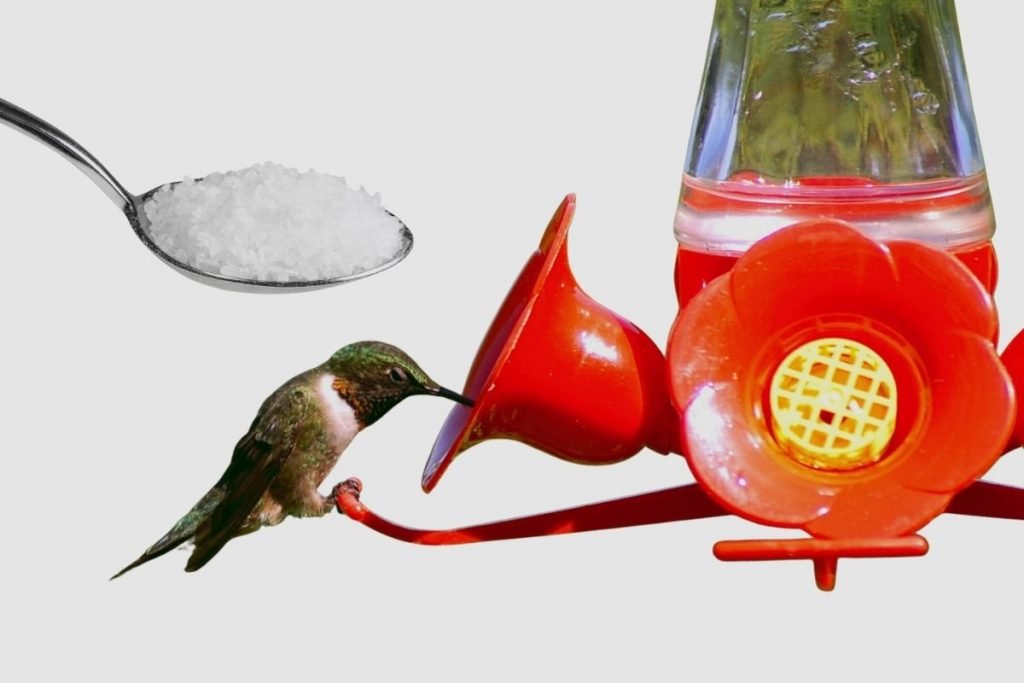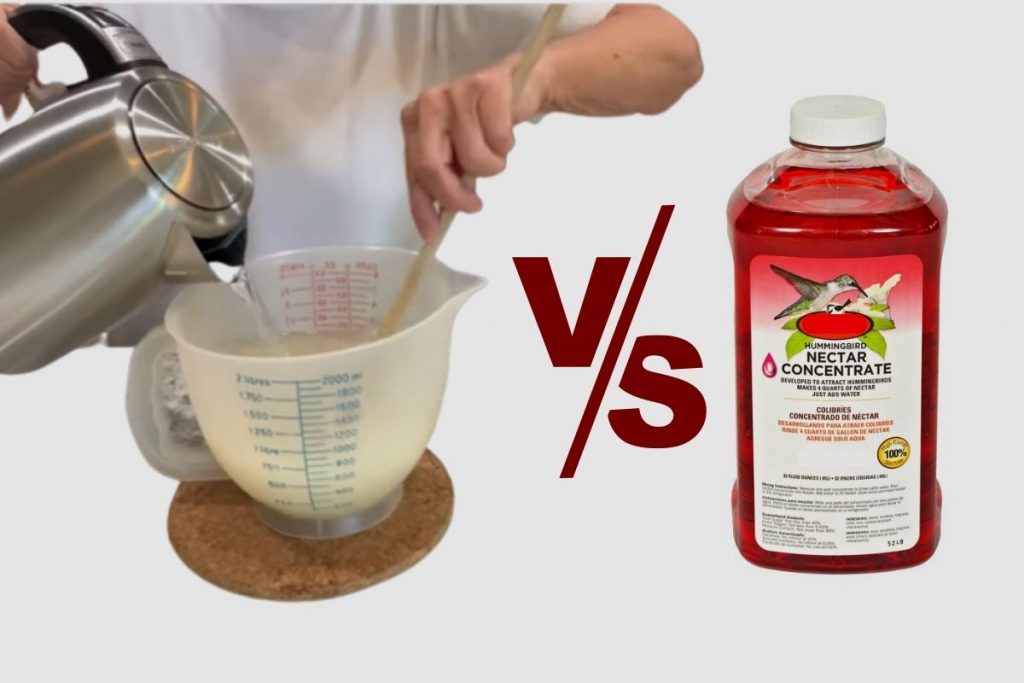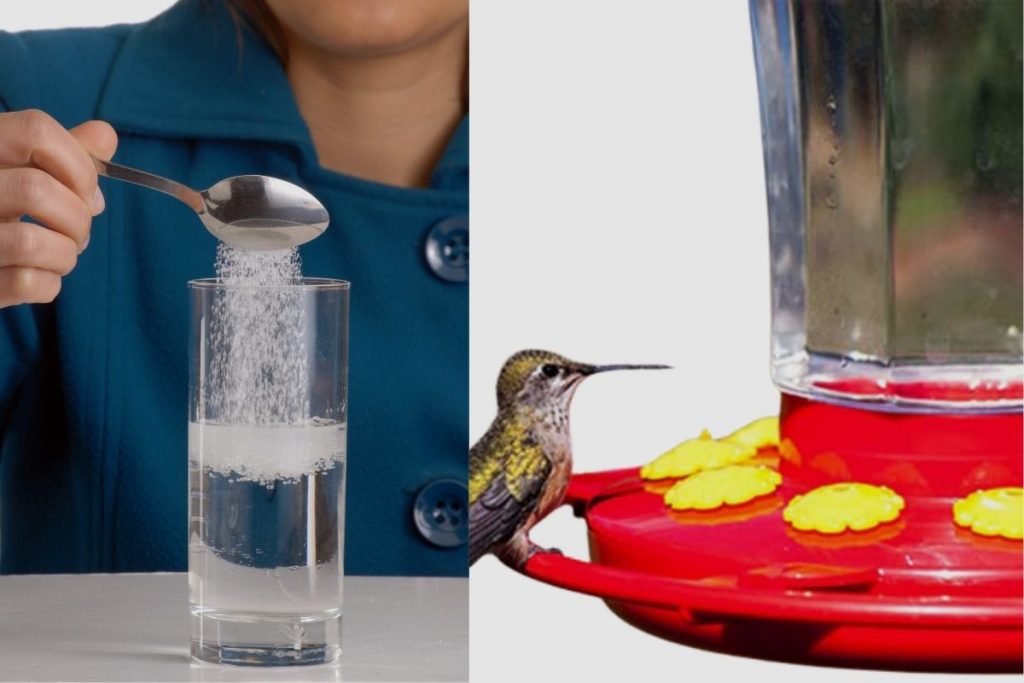When feeding Hummingbirds, the ideal sugar-to-water ratio for a hummingbird feeder is 1:4. That is to say, for every one part of sugar, you should use four parts of water. So, if you’re using a cup of sugar, you’d mix it with four cups of water to achieve the right balance.
In this blog post, we will delve deeper into the fascinating world of hummingbirds, their dietary requirements, and how you can best support them with appropriately mixed hummingbird feeders. We will walk through the importance of this precise sugar-water ratio, how to mix and maintain your feeder, as well as tips on using natural sources of nectar.
- The Science Behind the Sugar
- Mixing The Perfect Hummingbird Food
- Keeping Your Feeder Fresh and Clean
- Enhancing Natural Nectar Sources
- How Long Is Sugar Water Good For In a Hummingbird Feeder?
- What Are Some Tips for Preparing and Maintaining a Hummingbird Feeder?
- Conclusion
- FAQs – How Much Sugar Should You Use In a Hummingbird Feeder?
- Q: What type of sugar should I use in my hummingbird feeder?
- Q: Can I use honey, brown sugar or artificial sweeteners instead?
- Q: How do I prepare the sugar water solution for my feeder?
- Q: Can I prepare the sugar water solution in advance?
- Q: How often should I clean my hummingbird feeder?
- Q: When should I change the sugar water in the feeder?
- Q: What type of flowers can I plant to attract hummingbirds?
- Q: Are pesticides safe to use in my garden with a hummingbird feeder?
- Q: Why should the hummingbird feeder be placed in a partially shaded area?
- Q: How high off the ground should the feeder be placed?
- Q: Why might it be helpful to have multiple hummingbird feeders?
- Q: Is the colour of the hummingbird feeder important?
- Q: Should I refill the feeder if the nectar level is still half full?
- Q: Does the frequency of hummingbird visits change with the seasons?
- Q: How Much Sugar Should I Use For 2 Cups Of Water For Hummingbird Food?
- Q: Is A 3 To 1 Ratio OK For Hummingbirds?
- Q: Do I Need To Boil Sugar Water For Hummingbirds?
- Q: What Are the Benefits of Making Home-Made Nectar Solution Compared to Store-Bought Mix?
Related Posts:
Best Hummingbird Feeders.
Hummingbird Feeders Comprehensive Guide.

The Science Behind the Sugar
Hummingbirds, with their lightning-fast wings and seemingly endless energy, require an extremely high-calorie diet. Their natural food sources include a range of small insects and a high concentration of nectar from flowers.
Therefore, the sugar-water mix in a hummingbird feeder mimics this natural diet, providing the necessary energy for their high metabolism.
- The Sugar: Using plain white cane sugar in your feeder is the closest approximation to the natural sucrose found in flower nectar. Do not use honey, brown sugar, or artificial sweeteners, as they can be harmful to hummingbirds.
- The Ratio: A 1:4 sugar-to-water ratio is a good balance that closely resembles the sugar concentration in natural nectar sources. More sugar can dehydrate the birds, while less sugar may not provide enough calories.
Why Is the Sugar-to-Water Ratio Essential?
The balance of sugar to water in hummingbird nectar plays a pivotal role in fuelling the hummingbirds, matching their soaring energy demands and rapid metabolic pace.
An overly sweet solution can lead to a host of complications, including indigestion, weight gain, and other health-related concerns.
Conversely, a diluted solution may leave them underpowered, restricting their effervescent flight and dynamic activities.
Hence, striking an appropriate sugar-to-water ratio serves as a crucial element, underpinning the adequate nutrition of hummingbirds while sidestepping any potential health hazards.

Mixing The Perfect Hummingbird Food
Creating the optimal hummingbird food mix doesn’t require special skills. Here’s a step-by-step guide:
- Measure Out Your Ingredients: Start with one part sugar to four parts water. For instance, if you’re using a quarter cup of sugar, you’ll need a full cup of water.
- Heat Your Water: The water needs to be hot enough to dissolve the sugar but doesn’t need to be boiling.
- Dissolve The Sugar: Stir in the sugar until fully dissolved. You’re aiming for a clear solution, not cloudy.
- Cool Before Serving: Let the mixture cool before filling your feeder. Any leftover solution can be stored in the fridge for up to one week.
Keeping Your Feeder Fresh and Clean
Ensuring your feeder is clean and the food is fresh is vital for the health of visiting hummingbirds.
- Clean Regularly: A thorough cleaning with hot water and a feeder brush every few days will prevent mould growth.
- Change the Feed: During hot weather, change the feed every two days. In cooler temperatures, every four to five days should suffice.
Enhancing Natural Nectar Sources
While hummingbird feeders provide a helpful supplementary food source, promoting natural nectar sources in your garden is just as important. Planting nectar-rich flowers can turn your garden into a hummingbird paradise.
- Native Flowering Plants: Flowers like Salvia, Fuchsia, and Bee Balm are excellent choices.
- Avoid Pesticides: These can harm hummingbirds and their essential insect food sources.

How Long Is Sugar Water Good For In a Hummingbird Feeder?
The longevity of sugar water in a hummingbird feeder primarily depends on the surrounding temperature.
During warmer weather, the nectar solution should ideally be replaced every two to three days to prevent fermentation or mould growth that could be harmful to hummingbirds. In cooler conditions, the solution can remain fresh for around four to five days.
What Are Some Tips for Preparing and Maintaining a Hummingbird Feeder?
To prepare and maintain a hummingbird feeder effectively, several key steps can enhance its appeal to our winged companions while ensuring their well-being.
- Simplicity is Key: When preparing the nectar solution, avoid using anything other than plain white sugar and clean water. Additives, colouring agents, or alternative sweeteners can potentially harm the birds.
- Sunshade Positioning: Place your feeder in a partially shaded area. Direct sunlight can cause the nectar to ferment quickly, thus reducing its lifespan.
- Predator Protection: To keep the feeder safe from cats or other predators, position it at least 1.5 meters off the ground and away from any surfaces from which a predator could jump.
- Multiple Stations: To prevent territorial disputes, consider setting up more than one feeder. This will accommodate multiple hummingbirds simultaneously.
- Red is The Charm: Hummingbirds are attracted to the colour red. Using a feeder with red accents can make it more visible and inviting.
- Refill Regularly: Keep an eye on the nectar level in the feeder, ensuring it never runs dry. The constant availability of nectar will help create a reliable food source, attracting hummingbirds more consistently.
- Seasonal Adjustments: Be aware that feeder usage may increase during migration seasons when hummingbirds are in search of extra energy.
By adhering to these guidelines, your hummingbird feeder will serve as a safe, reliable, and delightful dining station for these energetic and enchanting birds.

Conclusion
In conclusion, serving up the perfect sugar-water mix in a hummingbird feeder requires a careful blend of science and care.
While the 1:4 sugar-water ratio feeds their high-energy needs, a clean feeder and plentiful natural nectar sources nurture their overall health and longevity.
Remember, our little winged visitors rely on us as much as we delight in their presence. Every detail counts in supporting their swift, vibrant lives.
As you refill your hummingbird feeder, perhaps you’ll pause for a moment and marvel at this sweet and simple connection we share with nature. Let’s make every drop count.
FAQs – How Much Sugar Should You Use In a Hummingbird Feeder?
Q: What type of sugar should I use in my hummingbird feeder?
A: Plain white cane sugar is the best choice for your hummingbird feeder. This closely mimics the natural sucrose found in flower nectar, which is easily digestible for hummingbirds.
Q: Can I use honey, brown sugar or artificial sweeteners instead?
A: No, honey, brown sugar, and artificial sweeteners should be avoided. These substances can be harmful to hummingbirds.
Q: How do I prepare the sugar water solution for my feeder?
A: Start with a ratio of one part sugar to four parts water. Heat the water (it doesn’t need to be boiling), stir in the sugar until it’s fully dissolved, and allow the mixture to cool before filling your feeder.
Q: Can I prepare the sugar water solution in advance?
A: Yes, any leftover sugar water solution can be stored in the refrigerator for up to one week.
Q: How often should I clean my hummingbird feeder?
A: You should clean your hummingbird feeder every few days with hot water and a feeder brush to prevent mould growth.
Q: When should I change the sugar water in the feeder?
A: The frequency of changing the sugar water depends on the weather. In hot weather, it’s recommended to change the feed every two days, while in cooler temperatures, every four to five days should be sufficient.
Q: What type of flowers can I plant to attract hummingbirds?
A: In the UK, hummingbirds are particularly attracted to native flowering plants such as Salvia, Fuchsia, and Bee Balm.
Q: Are pesticides safe to use in my garden with a hummingbird feeder?
A: It’s recommended to avoid using pesticides near your hummingbird feeder or in your garden, as they can harm hummingbirds and their essential insect food sources.
Q: Why should the hummingbird feeder be placed in a partially shaded area?
A: Placing the feeder in a partially shaded area prevents direct sunlight from causing the nectar to ferment quickly.
Q: How high off the ground should the feeder be placed?
A: To keep the feeder safe from predators, it should be positioned at least 1.5 meters off the ground.
Q: Why might it be helpful to have multiple hummingbird feeders?
A: Multiple feeders can prevent territorial disputes and allow for more hummingbirds to feed simultaneously.
Q: Is the colour of the hummingbird feeder important?
A: Yes, hummingbirds are attracted to the colour red. Therefore, using a feeder with red accents can make it more inviting.
Q: Should I refill the feeder if the nectar level is still half full?
A: Yes, maintaining a consistent nectar level ensures that hummingbirds perceive your feeder as a reliable food source, attracting them more consistently.
Q: Does the frequency of hummingbird visits change with the seasons?
A: Yes, hummingbirds may visit feeders more frequently during migration seasons when they are in need of extra energy.
Q: How Much Sugar Should I Use For 2 Cups Of Water For Hummingbird Food?
A: For 2 cups of water, you would need half a cup of sugar. This follows the recommended 1:4 sugar-to-water ratio for hummingbird food.
Q: Is A 3 To 1 Ratio OK For Hummingbirds?
A: A 3:1 water-to-sugar ratio may be too concentrated for hummingbirds and could potentially cause dehydration or other health problems. The generally accepted ratio is 4:1, providing the right balance of energy without causing harm.
Q: Do I Need To Boil Sugar Water For Hummingbirds?
A: The water needs to be hot enough to dissolve the sugar, but it doesn’t need to be boiling. The main aim is to ensure the sugar is completely dissolved to create a clear solution.
Q: What Are the Benefits of Making Home-Made Nectar Solution Compared to Store-Bought Mix?
A: Home-made nectar solution is simple and cost-effective. It allows you to control the quality and quantity of the ingredients, ensuring the absence of additives or preservatives which may be found in some store-bought mixes. Moreover, it is more environmentally friendly, reducing packaging waste.
References: Hummingbird, Bird Feeder.
